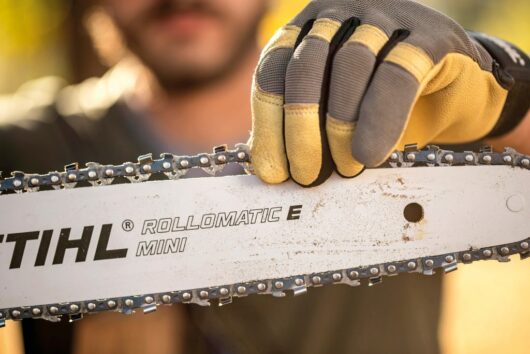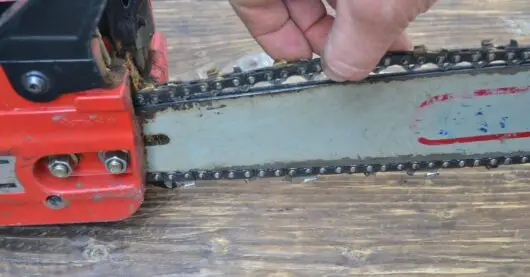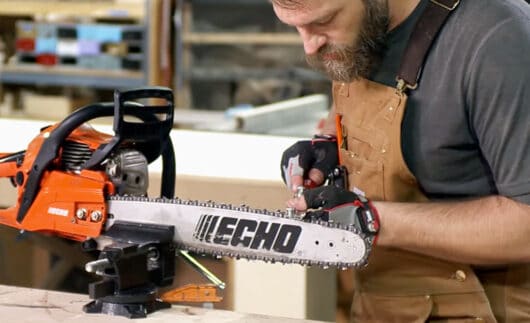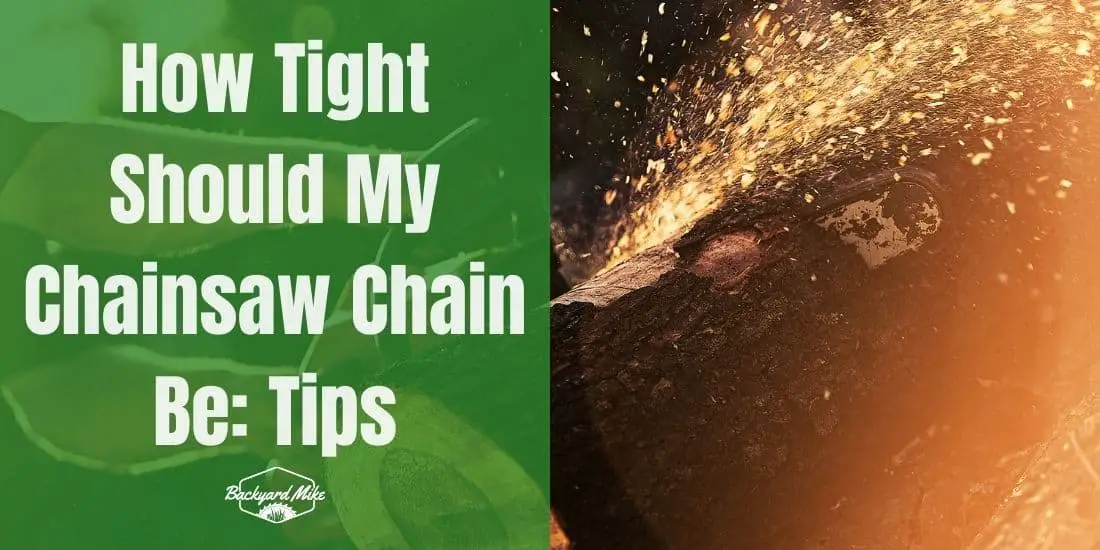Are you having difficulty adjusting the tension of your chainsaw chain? If you want your chainsaw to operate efficiently and safely, it is important to make sure the chain is adjusted properly. If the chain is too tight, it can cause damage to the bar, sprocket, and chain links. If the chain is too loose, it can slip off the bar or cause kickback. Read on to learn how to adjust the tension of your chainsaw chain correctly and safely, so you can get the job done right!
What is a chainsaw chain – Components of a chainsaw chain
A chainsaw is an extremely powerful and versatile tool that can be used for a wide variety of applications, like cutting trees, splitting firewood, trimming branches, and sculpting food. The chainsaw chain is one of the most important components of a chainsaw. It is responsible for the cutting action and carrying out the tasks.
A chainsaw chain is a loop made from cutting teeth, tie straps, and drive links. It’ll wrap around the chainsaw bar, which is the long, narrow metal guide on which the chain will slide. It is made using several components that work in tandem to ensure efficient and effective cutting. Here are the different components of a chainsaw chain –

#1. Chainsaw chain
The cutting teeth are the most important components of the chainsaw chain. They’ll come in different shapes, angles, and sizes, depending on the type of cutting application. For example, a chainsaw chain is used for cutting hardwood trees, and it has different teeth than a chain used for cutting softwood trees.
The cutting teeth are made using hardened steel, and they’re designed for staying sharp for an extended period of time. However, they’ll eventually become dull over time and have to be sharpened or replaced. It is important to keep the teeth sharp for efficient cutting and for avoiding unnecessary wear on the chainsaw motor.
#2. Drive links
The drive links are the small metal tabs that connect the chainsaw’s cutting teeth to the chainsaw bar. They come in a rectangular shape and engage with the sprocket of the chainsaw motor for driving the chain around the bar. These drive links are made using high-quality steel for withstanding the stress and heat generated by the chainsaw motor.
#3. Tie straps
The tie straps in a chainsaw are the small, curved pieces of metal that connect the drive links to the cutting teeth. They will keep the teeth aligned and spaced correctly, which ensures smooth and efficient cutting. The tie straps will be made using hardened steel to resist wear and gear.
#4. Rivets
The rivets are responsible for holding the cutting teeth and tie straps together. They’re made using hardened steel and need to be installed properly to make sure of the chain’s strength and durability.
#5. Depth gauges
Depth gauges are comparatively small protrusions located in front of the cutting teeth. They’ll regulate the depth of the cut, which prevents the chain from cutting too deep into the wood. The depth gauges have to be adjusted regularly for ensuring efficient and safe cutting.
#6. Bumper links
Bumper links are designed for reducing kickback by slowing down the movement of the chain when it contacts a hard object. They’re typically found at the base of the cutting teeth, and they’re made using softer metal than the rest of the chain.
#7. Lubrication holes
The lubrication holes are located in the drive links, and they allow oil to get distributed along the length of the chain for reducing friction and heat buildup. Proper lubrication will be important for the chain’s performance and longevity.
Different types of chainsaw chain
The chainsaw chain is easily one of the most important components of a chainsaw. With the right chainsaw chain, you’ll be able to get the appropriate performance out of your chainsaw. However, if you use the wrong chainsaw chain, it’ll not only affect the performance of your chainsaw but also end up damaging it or injuring you. The different types of chainsaw chains available in the market are –

#1. Standard chainsaw chain
The standard chainsaw chain is the most commonly used type of chainsaw chain. It features a round tooth shape that cuts through wood quickly and efficiently. This type of chainsaw chain will be ideal for general-purpose cutting tasks and is available in a wide variety of sizes.
#2. Low-profile chainsaw chain
The low-profile chainsaw chain features a lower profile than the standard chain, which makes it ideal for chainsaws that have smaller engines. This chain type has a semi-chisel tooth shape, which provides smoother and faster cutting action.
#3. Full-chisel chainsaw chain
The full-chisel chainsaw chain features a square-shaped tooth that is quite aggressive and provides fast cutting. This type of chain is ideal for cutting through hardwoods and frozen wood, but it’ll require more maintenance because of its tendency to become dull quickly.
#4. Semi-chisel chainsaw chain
The semi-chisel chainsaw chain comes with a rounded tooth shape that is more durable compared to the full-chisel chain. It’ll cut slower but maintains its sharpness for a longer time, which makes it ideal for cutting dirty wood or in sandy conditions.
#5. Carbide-tipped chainsaw chain
The carbide-tipped chainsaw chain features carbide inserts welded onto the teeth. This type of chain will provide excellent durability and cutting performance, which makes it ideal for cutting abrasive materials like brick, concrete, and stone.
#6. Ripping chainsaw chain
The ripping chainsaw chain features a special tooth design, which allows it to easily cut through the wood’s grain. This type of chain will be ideal for cutting logs into boards and is commonly used for woodcutting purposes.
#7. Safety chainsaw chain
The safety chainsaw chain features a unique design that reduces the kickback and makes it safer and easier to use. It comes with reduced depth gauges and rounded teeth, which makes it less aggressive compared to other types of chains.
How tight should the chainsaw chain be
Achieving optimal performance for your woodcutting needs doesn’t just end with buying the chainsaw. With a proper chainsaw, having proper tension will also be important. Now, the most common question among chainsaw users will be how tight should the chainsaw chain be.
The right chainsaw chain must “snap tight”. To get a better visual of what “snap tight” means, you will need to pull up the chain until the drive links are almost exposed, but they shouldn’t be free of the guide bar when pulled. A properly tight chainsaw must snap back once you have pulled it.
Here is how you can test the tension of the chainsaw chain –
#1. Snap test
You should pull the chain to do a snap test on the chainsaw. Try to pull as far as possible before you release it. If it springs back in place, you should consider that you’ve got a great chainsaw chain tension. The tension shouldn’t be too tight that you aren’t able to pull the chain away freely. Hence, the chain’s tension must be too loose that if you pull it away, it doesn’t snug back.
#2. Pull test
Generally, woodworkers prefer the pull test as it is straightforward and more effective. For performing a pull test, you’ll need to fix your finger grip on the chain as you’re pulling the chain away from the guide rail.
Ideally, your chainsaw’s chain should only lift partially away from the bar, while still having the drive links intact. The drive links shouldn’t fall off the groove after you pull it, and the ends should also remain intact to the bar groove.
Benefits of a tight chainsaw chain
It cannot be understated how important a chainsaw chain is to the chainsaw. With a properly tightened chainsaw, not only will you get the ideal performance, but it’ll also keep you and your chainsaw safe. Keeping the chainsaw chain tight by regularly maintaining it is important as it provides various benefits. Here are some of the benefits of a tight chainsaw chain –
#1. Efficient cutting performance
A properly tightened chainsaw chain will ensure that you get efficient cutting performance, as it’ll reduce vibration and minimize the risk of kickback. If the chain is loose, it can easily skip or jump off the guide bar, which makes cutting extremely difficult and dangerous. A tight chainsaw chain will ensure that the chainsaw chain remains in contact with the guide bar and provides a smooth and efficient cutting performance.
#2. Extended chain life
A tight chainsaw chain will increase the chain’s lifespan, as it’ll reduce wear and tear. When the chain is loose, it could rub against the guide bar, which causes excessive wear and tear. A tight chain, on the other hand, will keep the chain in its proper position, reducing friction and extending its life.
#3. Improved safety
A tight chainsaw chain will be safer to use than a loose chain. A loose chain can jump off the guide bar, which could cause serious injuries or damage to property. A tight chain will reduce the risk of kickback, allowing the chainsaw operator to maintain better control over the cutting process.
#4. Reduced maintenance
Maintaining a tight chainsaw chain will require less maintenance compared to a loose chainsaw chain. A loose chain will have to be adjusted frequently, which can be somewhat time-consuming and need additional tools. A tight chain, on the other hand, will have to be adjusted less frequently, which will reduce the time and effort needed for maintenance.
#5. Increased power
A tight chainsaw chain can increase the chainsaw’s power as it reduces energy loss. When the chain is loose, it can easily slip or skip, which can cause energy loss and reduce the chainsaw’s power. A tight chain will ensure that the chainsaw’s power will be utilized efficiently, which will allow for more effective cutting.
Important factors to consider when adjusting the chainsaw chain
Adjusting the chainsaw chain will be an important part of maintaining your chainsaw’s performance and safety. However, there are certain factors to consider when you are adjusting the chainsaw chain. Here are some of those factors –
#1. Chain tension
The first factor that you should consider when you’re adjusting your chainsaw chain will be the chain tension. The chain must be tight enough that makes sure you get efficient cutting performance, but not so tight that it puts undue stress on the chainsaw motor. A loose chain could end up damaging the guide bar and increase the risk of kickback. Meanwhile, an overly tight chain could cause the motor to overheat and reduce the power of the chainsaw. Chainsaw manufacturers generally provide guidelines for the correct chain tension. It is important that you follow these guidelines to make sure you’re getting safe and effective cutting.
#2. Chain sharpness
Another key factor that you should consider when you’re adjusting a chainsaw chain will be the sharpness of the chain. A dull chainsaw chain will require more force for cutting through wood, which increases the risk of kickback and reduces the chainsaw’s efficiency. It is important that you should regularly sharpen the chainsaw chain and replace it if it is worn out excessively to ensure efficient and safe cutting.
#3. Bar condition
The condition of the guide bar will be another factor that you should consider when you’re adjusting a chainsaw chain. The guide bar must be clean and free of any debris. Moreover, it shouldn’t be bent or damaged. A damaged or bent guide bar could cause the chain to bind or jump, which increases the risk of kickback and reduces the cutting efficiency. It is important that you regularly inspect the guide bar and replace it if it has been damaged.
#4. Oil lubrication
Proper oil lubrication will be important for maintaining the chainsaw chain’s performance and lifespan. The chain oil will lubricate the chain and reduce friction, which prevents any overheating and extends the life of the chainsaw chain. It is important that you ensure that the chainsaw’s oiling system is functioning properly. Further, make sure that you add oil regularly during regular use to ensure proper lubrication.
#5. Cutting conditions
The cutting conditions will also play a key role in adjusting the chainsaw chain. Thicker or harder wood will need a sharper and tighter chain compared to thinner or softer wood. It is important that you adjust the chainsaw chain tension and sharpen the chain based on the conditions and the wood you’re cutting to ensure safe and efficient cutting.
How to adjust the chainsaw chain tension
When it comes to maintaining the chainsaw chain, one of the most important aspects will be ensuring that the chainsaw chain tension is properly adjusted. A loose chain can increase the risk of kickback, whereas an overly tight chain could cause unnecessary wear and wear on the chainsaw.
Before you make any adjustments, it’ll be important to first check the current chain tension. For doing that, you must turn off the chainsaw and allow it to cool down. After that, use a gloved hand for pulling the chain away from the guide bar. You’ll be able to easily pull the chain around 1/4 inch away from the bar. If the chain is loose, and it can be pulled away from the bar, it’ll be time to make the adjustment.
The right way to adjust the chain tension will vary depending on the type of chainsaw you’re using. However, most chainsaws will either use a side-mounted tensioning screw or a tensioning wheel that you can use for adjusting the chain tension. For making the adjustment, you should loosen the locking nuts that secure the bar in place. After that, turn the tensioning screw or tensioning wheel for tightening or loosening the chain. Make small adjustments and check the chain tension periodically until it is at the desired tightness. Once you are happy with the tension, you must retighten the locking nuts, and you’ll be able to secure the bar in place.
Adjust the chain tension by adjusting the bar
In some cases, adjusting the tensioning screw or tensioning wheel might not be enough for achieving the desired chain tension. If this is the case, it might be necessary for adjusting the bar itself. For doing that, loosen the locking nuts that secure the bar in place. Then, use a flathead screwdriver for adjusting the tensioning pin located at the front of the bar. Turn the pin clockwise for increasing the tension or counterclockwise for decreasing tension.
Make small adjustments and check the tension periodically until it is at the desired tightness. Once you are happy with the chain tension, retighten the locking nuts for securing the bar in place.
Maintenance tips to keep the chainsaw chain tight
Regular maintenance will be key to keeping the chainsaw running safely and effectively. By following the maintenance tips, you will be able to keep your chainsaw’s performance at its optimum, while also ensuring it is safe to use.

#1. Regularly inspect your chainsaw chain
Before you use your chainsaw, it’ll be important that you inspect it for potential damage or wear and tear. You must check the chain, bar, sprocket, and other chain components. Further, ensure that the chain’s tension is adjusted properly. Inspect the air filter and clean it or replace it as needed for ensuring proper airflow. Additionally, check the spark plug and fuel filter. Replace them if needed.
#2. Keep the bar and chain clean
Keeping the bar and chain will be important for maintaining the performance of your chainsaw. After every use, remove any debris from the chainsaw bar and chain using a brush or compressed air. After every use, you must use a specialized chainsaw cleaner for removing any stubborn debris. It is also important that you regularly lubricate the bar and chain to reduce friction and prevent damage.
#3. Sharpen the chainsaw chain
A dull chainsaw chain could increase the risk of kickback, decrease the cutting efficiency, and put any unnecessary strain on the chainsaw’s motor. For sharpening the chainsaw, you must first make sure that the chain is tensioned properly. After that, use a specialized chainsaw file and carefully sharpen each tooth at the same angle (around 25-30 degrees). Make sure that each tooth is evenly sharpened and has the same length, shape, and depth.
#4. Other maintenance tips
Aside from these three essential maintenance tips, there are a few other things that you must do to keep your chainsaw in ideal condition. First, you must always use the appropriate fuel and oil mix recommended by the manufacturer. Using the wrong fuel mix could result in damage to the chainsaw’s engine. It is also important that you store your chainsaw properly, preferably in a dry, cool, and well-ventilated area. Lastly, you must consider having the chainsaw serviced professionally at least once a year, especially if you’re using it frequently or use it for heavy-duty tasks.
Also Read: How To Sharpen Chainsaw Blade
FAQs
What is the right amount of tension on a chainsaw chain?
The tension on a chainsaw chain should be tight enough to prevent it from coming off the bar, but not so tight that it causes excessive wear on the bar or chain. The correct tension should be enough to make the chain sag one half to three quarters of an inch when pulled up from the bottom of the bar.
How do I know if the tension on my chainsaw chain is correct?
The tension on a chainsaw chain can be checked by lifting the chain away from the bar. If the chain sags one half to three quarters of an inch, then the tension is correct. If the chain does not sag or sags more than three quarters of an inch, then the tension needs to be adjusted.
What are the signs of a chainsaw chain that is too loose or too tight?
If the chainsaw chain is too loose, it can come off the bar and become entangled, resulting in damage to the bar or chain. If the chain is too tight, it can cause excessive wear on the bar and chain due to friction. Additionally, if the tension is too tight, the chain can become difficult to start, and the engine may overheat due to strain.


